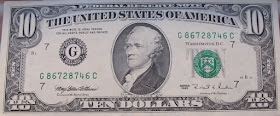Have a $2.00 bill and want to find out its value? Leave a comment
Currency
Overprinting and
Processing
Equipment (COPE) notes were new back in the 1970s and replaced conventional notes slowly over the years. COPE notes were printed, cut, sorted, inspected, and packed all on one machine. The older conventional notes had this done on different machines and in stages.
Both types are common, have equal value, and are not all that collectible. Yet there is enough interest that you should know how to identify them.
I will give you a minute to click on the picture above and try to tell the difference.
Well below I made it easier to notice the slight differences.
Conventional serial number checklist:
- Normal or slightly thinner letter and numbers.
- Thinner kerning or spacing.
- G is more square, A has a larger upper triangle, 6 has a larger lower circle.
COPE serial number checklist:
- Bolder or slightly thicker letter and numbers.
- Larger kerning or spacing.
- G is more round, A has a smaller upper triangle, 6 has a smaller lower circle.
Conventional stats...
Type/Country: 2 Dollars / United States
Year: 1976
Date Printed: December 1975 - August 1976
Printings: 84,480,000
Run: 72nd from 59-73 of 132 the G45440001A - G46080000A
Value: $2.50 in Almost Uncirculated
COPE stats...
Type/Country: 2 Dollars / United States
Year: 1976
Date Printed: December 1975 - August 1976
Printings: 84,480,000
Run: 76th from 74-132 of 132 the G48000001A - G48640000A
Value: $2.50 in Almost Uncirculated
Sharp eyed viewers may notice that the conventional note has a slight Misaligned Overprint error, but nothing to add any extra value.
Do
you have a two dollar bill and want to know its value? Leave a
comment/question and I will do my best to find out the price and history
for you.
































